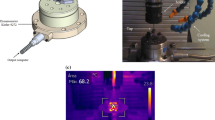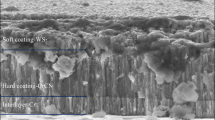Abstract
Currently, carbon fibre–reinforced polymer composites are used in many industrial applications because they can replace traditional materials such as wood, metal, and in some situations even the concrete. It can be supported that the aerospace and space industries were the first to use carbon fibre–reinforced polymer (CFRP) in their components. The high modulus of CRFP provides a structural strength allowing the replacement of traditional alloys such as aluminium and titanium. This study aims an experimental investigation of the cutting forces in tapping process using CFRP samples. The experiments were performed using a full factorial design varying coating, axial compensation, and cutting speed. The thread profile quality was verified, and the torque thread resistance was verified providing a better knowledge about the tapping process in CFRP. The thrust force results showed that the axial compensation combined with cutting speed and the uncoated tool had different effects, and the combination resulted in higher thrust force values. The resistance in the torque tests of the thread profiles varied between 8 and 10 N m, and the statistical analysis showed that the influence of the cutting speed of 15 m/min was 31.06% smaller than the cutting speed of 5 m/min. Furthermore, the torque with coated tool was 36.25% less than the uncoated tool. Moreover, the thread profile resistance was better when it used the higher speed and the floating axial compensation. Finally, based on the ISO metric thread basic profile, the thread profiles showed an important quality.













Similar content being viewed by others
References
Abhishek K, Datta S, Mahapatra SS (2014) Optimization of thrust, torque, entry, and exist delamination factor during drilling of CFRP composites. Int J Adv Manuf Technol 76(1–4):401–416
Abrão AM et al (2007) Drilling of fiber reinforced plastics: a review. J Mater Process Technol 186(1–3):1–7
Liu D, Tang Y, Cong WL (2012) A review of mechanical drilling for composite laminates. Compos Struct 94(4):1265–1279
Davim, J. P.; Reis, P. Drilling carbon fiber reinforced plastics manufactured by autoclave—experimental and statistical study. Mater Des, v. 24, n. 5, p. 315–324, ago. 2003
Tsao CC, Hocheng H (2007) Effect of tool wear on delamination in drilling composite materials. Int J Mech Sci 49(8):983–988
Grilo TJ et al (2013) Experimental delamination analyses of CFRPs using different drill geometries. Compos Part B 45(1):1344–1350
Campos Rubio JC et al (2013) Investigations on the drilling process of unreinforced and reinforced polyamides using Taguchi method. Compos Part B 55:338–344
Shetty, N. et al.2016 Soft computing techniques during drilling of bi-directional carbon fiber reinforced composite. [s.l.] Elsevier B.V., v. 41
Durão LMP et al (2015) Damage assessment of fibre reinforced laminates. Compos Struct 133:939–946
Chen, N. M.; SMITH, A. J. R.2011 Proceedings of the Institution of Mechanical Engineers, Part B: Journal of Engineering Manufacture
Armarego, E. J. A.; Chen, M. N. P. Predictive cutting models for the forces and torque in machine tapping with straight flute taps. CIRP Ann Manuf Technol, v. 51, n. 1, p. 75–78, 2002
Ahn JH et al (2003) Effects of synchronizing errors on cutting performance in the ultra-high-speed tapping. CIRP Ann Manuf Technol, v 52(1):53–56
Popović M, Stoić A, Tanović L (2016) Prediction of tapping forces and torque for 16MnCr5 alloyed steel. Tehnicki vjesnik/Technical Gazette 23(3)
Mezentsev OA et al (2002) Use of radial forces for fault detection in tapping. Int J Mach Tools Manuf 42(4):479–488
Dogra APS, Kapoor SG, Devor RE (2002) Mechanistic model for tapping process with emphasis on process faults and hole geometry. J Manuf Sci Eng, Trans ASME 124(1):18–25
Uzun G, Korkut I (2013) The effect of cryogenic treatment on tapping. Int J Adv Manuf Technol 67(1–4):857–864
Uzun G, Korkut I (2016) The effects of cutting conditions on the cutting torque and tool life in the tapping process for AISI 304 stainless steel. Mater Tehnol 50(2):275–280
Montgomery, D. C. Design and analysis of experiments. Technometrics, v. 48, n. 1, p. 158–158, fev. 2006
Nedic, B., Lakic Globocki, G.L. Friction coefficient for all alloys and tool materials contact pairs. Tribol Ind, vol. 27(3–4), pag.53–56. 2005
Chu K, Shen YG (2008) Mechanical and tribological properties of nanostructured TiN/TiBN multilayer films. Wear 265(3–4):516–524
Carvalho AO, Panzera TH, Cardoso BL, Lauro CH (2012) Analysis of form threads using fluteless taps in cast magnesium alloy (AM60). J Mater Process Technol 212:1753–1760
Lee SM et al (2009) Friction drilling of austenitic stainless steel by uncoated and PVD AlCrN- and TiAlN-coated tungsten carbide tools. Int J Mach Tools Manuf 49:81–88
SAITO Y et al (2016a) Development of a new tapping tool covered with nickel/abrasive particles composite film for preventing chip snarling and tool service life extension. Tribology Online 11(2):81–87
Ribeiro Filho SLM et al (2016) Effects of the dynamic tapping process on the biocompatibility of Ti-6Al-4V alloy in simulated human body environment. Arab J Sci Eng Section b: Eng, v 41:4313–4326
Ribeiro Filho SLM, Vieira JT, de Oliveira JA, Arruda ÉM, Brandão LC (2017) Comparison among different vegetable fluids used in minimum quantity lubrication systems in the tapping process of cast aluminum alloy. J Clean Prod 140:1255–1262
Pereira, I. C., Silva, M. B., Study of the internal thread process with cut and form taps according to secondary characteristics of the process, Int J Adv Manuf Technol, 93/5–8, 2357–2368, 2017
Pereira IC et al (2016) Analysis of tapping process in three types of cast iron. Int J Adv Manuf Technol 82(5–8):1041–1048
ISO 68-1:1998,1998 General purpose screw threads - basic profile - part 1: metric screw threads, Ed. 1, pp. 1–3,
ISO 68-2:1998,1998 General purpose screw threads - basic profile - part 1: metric screw threads, Ed. 1, pp. 1-3,
Acknowledgements
The authors thank CAPES - Coordination for Higher Education Staff Development for the financial support and Emuge-Franken for the support for the supply of the tooling.
Author information
Authors and Affiliations
Corresponding authors
Additional information
Publisher’s note
Springer Nature remains neutral with regard to jurisdictional claims in published maps and institutional affiliations.
Rights and permissions
About this article
Cite this article
de Freitas, S.A., Vieira, J.T., Filho, S.L.M.R. et al. Experimental investigation of tapping in CFRP with analysis of torque-tension resistance. Int J Adv Manuf Technol 104, 757–766 (2019). https://doi.org/10.1007/s00170-019-03955-0
Received:
Accepted:
Published:
Issue Date:
DOI: https://doi.org/10.1007/s00170-019-03955-0




